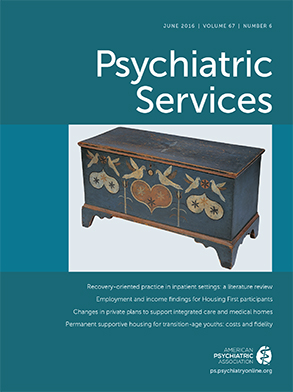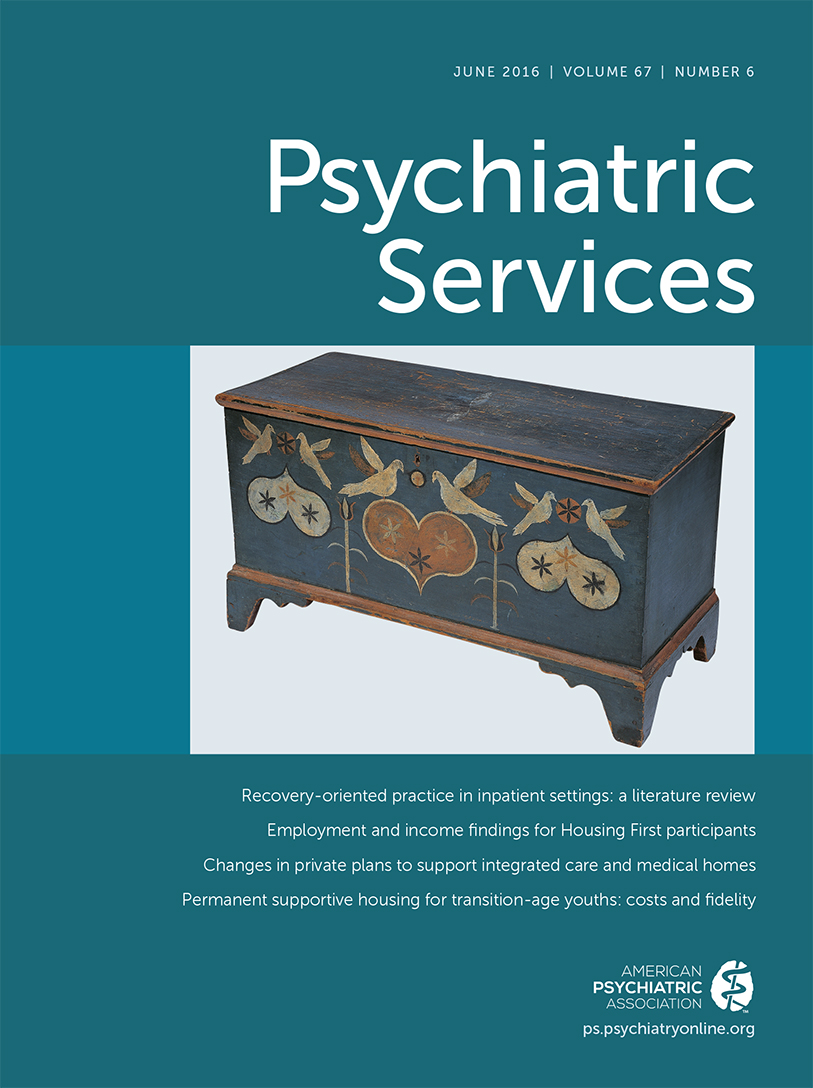APA-APM report reviews evidence for the collaborative care model: A joint work group of the American Psychiatric Association (APA) and Academy of Psychosomatic Medicine (APM) has issued a report that reviews current evidence for integrated care, specifically the collaborative care model (CCM), and provides recommendations for advancing use of the model. The 85-page report,
Dissemination of Integrated Care Within Adult Primary Care Settings: The Collaborative Care Model, highlights five successful examples of model implementation: Washington State Mental Health Integration Program (MHIP); Depression Initiative Across Minnesota, Offering a New Direction (DIAMOND); Re-Engineering Systems of Primary Care Treatment of PTSD and Depression in the Military (RESPECT-MIL); and approaches used by the Veterans Health Administration and by the University of California Davis Health System. Extensive research supports CCM’s four key principles of care provision: team driven, population focused, measurement guided, and evidence based. The model involves a multidisciplinary team that is led by a primary care provider and that includes care managers, psychiatrists, and frequently other mental health professionals. The report concludes with recommendations for future directions in three areas: education and training, implementation support, and payment reform. The report is intended to facilitate standardization of educational materials and messaging for APA and APM membership and to inform policy makers, external and allied organizations, health system partners, payers, and the general public. The report is available on the APA Web site (
http://www.psychiatry.org/psychiatrists/practice/professional-interests/integrated-care/collaborative-care-model).
New APA practice guideline on antipsychotics for patients with dementia: APA has released a set of 15 evidence-based recommendations for improving care for a vulnerable and growing population.
Practice Guideline on the Use of Antipsychotics to Treat Agitation or Psychosis in Patients With Dementia recommends judicious use of antipsychotics for these conditions in this population. Except for emergency situations, antipsychotics should be used only “when symptoms are severe, are dangerous, and/or cause significant distress to the patient.” The 210-page guideline emphasizes person-centered treatment planning that is focused on quality of life and that involves patients, family members, surrogate decision makers, and others in all decisions. The guideline development group, which included psychiatrists and experts from other disciplines (nursing, neurology, and geriatrics), reviewed 45 randomized controlled trials and 52 observational studies and systematically rated the strength of the evidence and of each recommendation. APA also surveyed nearly 600 peer-nominated experts in dementia and antipsychotics. To solicit perspectives of patients, families, and other care partners, the Alzheimer’s Association was asked to review the draft. Public comments, invited in July 2015, were received from 44 individuals and 11 organizations. The executive summary of the guideline appears in the May issue of
The American Journal of Psychiatry (
http://ajp.psychiatryonline.org/doi/full/10.1176/appi.ajp.2015.173501).
CDC calls on health professionals to refer young children to therapy before prescribing ADHD drugs: New guidance for health professionals from the Centers for Disease Control and Prevention (CDC) reinforces the American Academy of Pediatrics’ recommendation that before prescribing medications to young children (ages two to five) with attention-deficit hyperactivity disorder (ADHD), providers should refer parents to training in behavior therapy. Of the more than six million U.S. children with ADHD, about two million were diagnosed before age six. The report looks at claims data for young children with ADHD insured by Medicaid (2008–2011) or through employer-sponsored plans (2008–2014). In both groups, about 75% received medications for ADHD. (In the privately insured group, 2014 data showed that 49% received only medications.) About half of each group received any form of psychological services, and this proportion has not increased over time, according to the report. “Behavior therapy is an important first step,” said Anne Schuchat, M.D., principal deputy director of the CDC. “It has been shown to be as effective as medicine, but without the risk of side effects. We are still learning about the potential unintended effects of long-term use of ADHD medicine on young children.” In behavior therapy, parents are trained by a therapist during eight or more sessions, learning strategies to encourage positive behavior, discourage negative behaviors, improve communication, and strengthen their relationship with their child. The illustrated guidance document is part of the CDC’s
Vital Signs series (
http://www.cdc.gov/vitalsigns/adhd/infographic.html#graphic).
SAMHSA publication highlights benefits to children served by systems of care: A new report from the Substance Abuse and Mental Health Services Administration (SAMHSA) shows that supports provided through community-based systems of care can have far-reaching benefits for children and adolescents with mental disorders. Since 1993, SAMHSA has provided grants to communities to support systems of care, in which local child-serving agencies forge partnerships to coordinate evidence-based services with the goal of improving the functioning of children in school, at home, and in the community. According to research cited in the report, the rate of suicidal thoughts and attempts among children dropped significantly in the year after they gained access to system-of-care services. Strong partnerships forged between behavioral health and juvenile justice agencies under this model have been shown to reduce juvenile arrest rates. The four-page report is available on the SAMHSA Web site (
www.samhsa.gov/children).
Kaiser Foundation chart collection summarizes national behavioral health data: The Kaiser Family Foundation has created a collection of 36 charts entitled “What Are Costs and Outcomes Related to Mental Health and Substance Abuse Disorders?” The charts can be used individually or as a slideshow to provide a comprehensive overview of the latest statistics on behavioral health disorders in the United States. The collection explores prevalence, outcomes, access to care, and overall spending. The charts provide international comparisons and summarize demographic and other data about the most common disorders among U.S. adults and children. Several charts examine the nation’s opioid analgesic abuse epidemic, including a presentation of recent poll findings and information on overdose deaths. The chart collection is part of the Peterson–Kaiser Health System Tracker (
http://www.healthsystemtracker.org), an online information hub dedicated to monitoring and assessing the performance of the U.S. health system. In addition to chart collections, the site features a blog, videos, “insight briefs,” and interactive tools.
AHRQ report shows gains in access to and affordability of health insurance: With implementation of the Affordable Care Act (ACA), more people have health care coverage, have a usual place to go for medical care, and can more easily afford medical bills, according to the 13th in a series of annual reports by the Agency for Healthcare Research and Quality (AHRQ). The 2015
National Healthcare Quality and Disparities Report and 5th Anniversary Update on the National Quality Strategy presents data on more than 250 measures of quality, access, and disparities covering an array of health care services and settings. The rate of uninsured Americans under age 65 has decreased from 18% to 10%, according to the report. For those ages 18 to 29, the uninsured rate declined by more than half, from 31% to 15%. Among adults living in poverty, the uninsured rate fell from 44% to 25%. Disparities related to race, ethnicity, and socioeconomic status continue to affect care for many people. For example, the quality of care for blacks, Hispanics, and American Indians and Alaska Natives was worse than that for whites for about 40% of the report’s measures. This year’s report is the first to include an update on the U.S. Department of Health and Human Services’ National Quality Strategy, which was established by the ACA to set priorities and monitor progress toward quality, access, and affordability goals. The 30-page report is available on the AHRQ Web site (
http://www.ahrq.gov/research/findings/nhqrdr/nhqdr15/index.html).
CMS launches large multipayer initiative to improve primary care: The Centers for Medicare and Medicaid Services (CMS) has undertaken its largest-ever initiative to improve delivery of and payment for primary care. The Comprehensive Primary Care Plus (CPC+) model will be implemented in up to 20 regions and can accommodate up to 5,000 practices, encompassing more than 20,000 providers and 25 million people. The five-year CPC+ model is designed to help practices move away from one-size-fits-all, fee-for-service health care. The initiative will give providers greater flexibility in patient care and pay providers for achieving results. Primary care practices will participate in one of two tracks. In track 1, CMS will pay practices a monthly care management fee in addition to the fee-for-service payments under the Medicare Physician Fee Schedule for activities. Practices in track 2 will provide more comprehensive services for patients with complex medical and behavioral health needs. Track 2 practices will receive a monthly care management fee and, instead of full Medicare fee-for-service payments for Evaluation and Management services, will receive a hybrid of reduced Medicare fee-for-service payments and up-front comprehensive primary care payments for those services. This hybrid payment design will allow greater flexibility in how practices deliver care outside the traditional face-to-face encounter. More information about the CPC+ model, including a fact sheet, is available on the CMS site (
http://innovation.cms.gov/initiatives/Comprehensive-Primary-Care-Plus).
Urban Institute primer on payment reform for physicians and hospitals: The Urban Institute has prepared a useful primer that describes the basic mechanisms along with the design nuances of nine different payment methods that are in common use or have been proposed as reforms: fee schedules for physicians, primary care capitation, per diems for hospitals, diagnosis-related groups for hospitals, global budgets for hospitals, bundled episodes payment, global capitation, shared savings, and pay-for-performance. The report examines how operational design features of the various payment methods affect the behavior of health care providers. The strengths and weaknesses of stand-alone payment methods are examined, but because the newer methods are often implemented alongside older approaches, the report describes how the various methods are likely to interact with each other so that organizations can consider adopting hybrid models that take advantage of strengths and mitigate weaknesses. The report also examines how payment methods can be blended with benefit design to improve care delivery. The 70-page report,
Payment Methods: How They Work, is available on the Urban Institute’s Web site (
http://www.urban.org/research/publication/payment-methods-how-they-work).
Updated HHS guidance on improving health care access for justice-involved individuals: The Department of Health and Human Services (HHS) has released new guidance to clarify and update policies related to connecting justice-involved individuals to Medicaid coverage and services critical for successful community reentry. Under the newly issued guidance, states must accept Medicaid applications from incarcerated individuals, and persons determined to be eligible may be enrolled in Medicaid while they are inmates, with states suspending their eligibility status or limiting Medicaid billing to qualifying inpatient services. The guidance also reinforces that individuals who are on parole or probation, under home confinement, or living in the community awaiting trial are not considered to be inmates of a public institution and are thus eligible to receive Medicaid-covered services. The 14-page guidance letter is available on the
Medicaid.gov Web site (
https://www.medicaid.gov/federal-policy-guidance/downloads/sho16007.pdf).

